
19th Century Banquet Lamp with Putto Base and Bird Decoration
Banquet lamp, a 19th century kerosene lamp. Spelter base depicting figural putto holding font and shade aloft. Milkglass shade and font with pale blue highlights and embossed bird decoration. Height 71 cm, (a/f chip to shade)

Antique Bismarck Style Oil Lamps Pair, 19th/20th Century
Two antique Bismarck style oil lamps, one in milk glass with single burner and the other with milk glass shade on cast metal vase base and single burner, 19th/20th century, the larger 52 cm high overall

Antique Oil Lamp with Blue Glass Font and Metal Base
An antique oil lamp with case metal pagoda base, blue pressed glass font, duplex black button double burner and chimney with later frosted glass shade, 19th century, 71 cm high overall

Victorian Ruby Glass Oil Lamp with Cast Iron Base
Victorian ruby glass oil lamp, moulded cast iron base with ruby glass reservoir shade and clear glass chimney, height 38 cm

Victorian Ruby Glass Oil Lamp with Cast Iron Base
Victorian ruby glass oil lamp, moulded cast iron base with ruby glass reservoir shade and clear glass chimney, height 33 cm

Victorian Ruby Glass Oil Lamp with Cast Iron Base
Victorian ruby glass oil lamp, moulded cast iron base with ruby glass reservoir shade and clear glass chimney, height 36 cm

Victorian Ruby Glass Oil Lamp with Cast Iron Base
Victorian ruby glass oil lamp, moulded cast iron base with ruby glass reservoir shade and clear glass chimney, height 35 cm
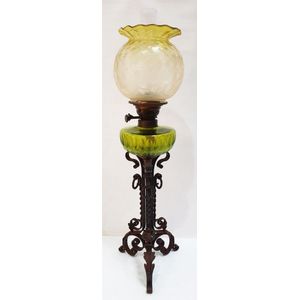
Green Cut Glass Oil Lamp with Wrought Metal Stand
A late 19TH/Early 20th century oil lamp, green cut glass reservoir on an ornate wrought metal stand, dimpled shade etched with flowers and citron tint, the mechnanism marked 'B Cars'. Height 78 cm.
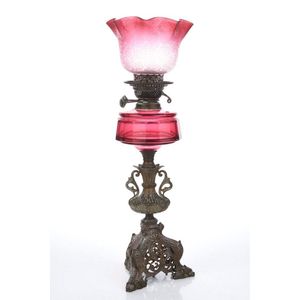
Victorian Ruby Glass Oil Lamp with Etched Shade, 19th Century
A Victorian ruby glass and metal oil lamp with etched shade, English 19th century, 61 cm high

19th Century Pink Tinged Opaque Glass Oil Lamp
A large painted pink tinged opaque glass and metal oil lamp, 19th century, 65 cm high 34 cm diameter to the shade

Victorian ruby and clear glass oil lamps, 19th century
A pair of Victorian ruby and clear glass and spelter oil lamps, English 19th century, 48 cm high with chimneys
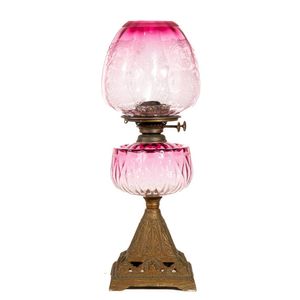
Victorian Pink Glass Kerosene Lamp with Cast Metal Base
A Victorian pink glass kerosene lamp on cast metal base, height 57 cm, comes with glass chimney

Victorian Banquet Lamp with Dolphin Base and Frosted Shade
Victorian banquet lamp, quality copper finish, cast iron dolphin decorated base with yellow floral design font and etched frosted green and clear floral design shade, height 61 cm
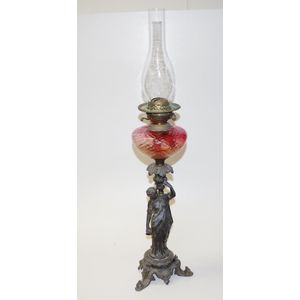
Antique Figural Cast Metal Kerosene Banquet Lamp with Ruby Glass
Antique figural cast metal kerosene banquet lamp with ruby glass reservoir and twin burners, height 79 cm

Antique Decorated Cast Iron Banquet Lamp with Etched Shade
Antique decorated cast iron based banquet lamp decorated cast iron base, supporting decorated amber glass reservoir, to double burner, with spherical etched glass lamp shade, height 70 cm

Antique Ruby Glass Banquet Lamp with Cast Iron Base
Antique cast iron based ruby glass banquet lamp decorated cast iron base, to decorated column, supporting a clear glass reservoir, with double burner, to decorated ruby glass shade, height 68 cm
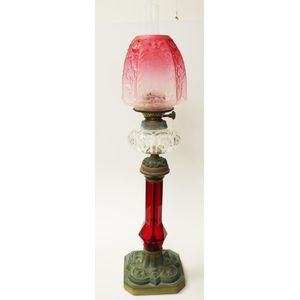
Antique Ruby Glass Banquet Lamp with Crystal Reservoir and Shade
Antique ruby glass decorated banquet lamp tall ruby glass column, supporting cut crystal fuel reservoir, to dual burner, and decorative ruby glass shade, bronzed metal base, height 70 cm

Antique Ruby Glass Kerosene Banquet Lamp with Double Burners
Antique ruby glass kerosene fuel banquet lamp ruby glass shade and reservoir, double burners, glass inn er funnel, to decorated cast iron base, height 61 cm, total.
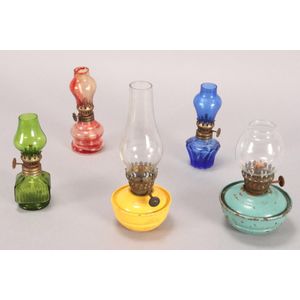
Quantity of Glass and Metal Petit Oil Lamps
Quantity petit oil lamps, including glass and metal lamps (quantity)

Victorian White Metal Oil Lamps Set
Three Victorian white metal oil lamps, 19th century, comprising an urn form lamp with twin chimneys, a baluster lamp with flora in relief, and; a censer form lamp, two with EPBM marks, the censer with marks for James Dixon & Sons, all with original…
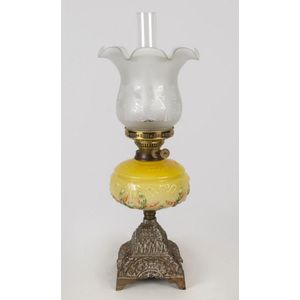
19th Century Yellow Glass Kerosene Lamp
An antique kerosene lamp, cast metal base with yellow glass font, double burner and reproduction shade and chimney, 19th century, 57 cm high overall

Green Glass Fuel Lamp with Rococo Base
A French spelter and glass fuel lamp, late 19th century with a pierced rococco base surmounted by a bulbous green glass font, with a burner and clear glass chimney. Height 55 cm

Etched Ball Pink Glass Kerosene Lamp - 63cm Height
A tall kerosene lamp with metal column stem, pink pressed glass font and etched ball shade, height 63 cm
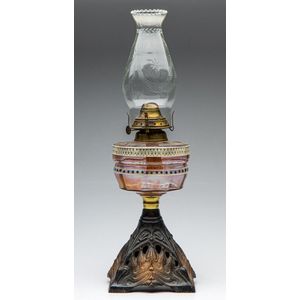
Pink Metal Kerosene Lamp with Cut Glass Chimney
A metal based kerosene lamp with pink font and cut glass chimney with sash detail, height 50 cm

Late 19th Century American Milk Glass Kerosene Lamp
An antique American milk glass kerosene lamp, late 19th century, an amber toned ruffled shade above a floral decorated milk glass font and a pierced metal base, with American fittings and chimney, 48 cm high
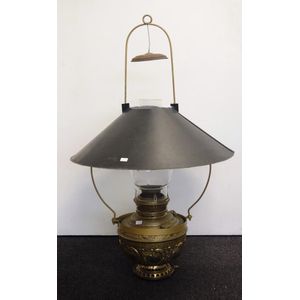
Vintage Oil Lamp with Metal Shade and Glass Flue
Vintage oil lamp with metal shade and glass flue, height base only 30 cm

Victorian Ruby Glass Oil Lamp on Metal Base
A Victorian oil lamp, with faceted ruby glass reservoir and shade on a floral decorated downswept metal platform base. Height 57 cm.
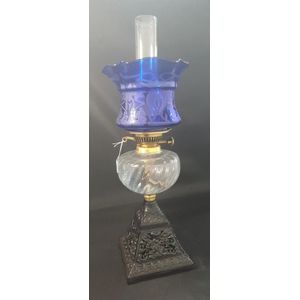
Victorian Oil Lamp with Cobalt Blue Etched Shade
A Victorian oil lamp, with faceted glass reservoir and a cobalt blue etched shade, on a floral decorated downswept metal platform base. Height 59 cm.

19th Century Onyx and Pink Glass Banquet Lamp
An antique banquet lamp, onyx and gilt metal column base, pink glass font, black button double burner with bayonet mount and acid etched shade, 19th century, 75 cm high overall

French Neoclassical Kerosene Lamps with Bronze Mounts
A pair of French spelter and bronze kerosene lamps, late 19th century, the neoclassical style cast spelter waisted urn form bases with bronze decorative mounts, twin-handles and collar, all raised on scrolled legs, with electrical conversion, burner…

Cast Iron Parlor Lamp with Ruby Glass Shade
Vintage cast iron based parlour lamp, tall oil parlour lamp with pierced cast iron base, crystal reservoir and ruby glass shade and chimney

Classical Victorian Gilt Metal Oil Lamp, Electrified
A Victorian gilt metal oil lamp, in the classical style, formed as a tripod with three snake wreathed herns on a leaf cast base, electrified, height 62 cm
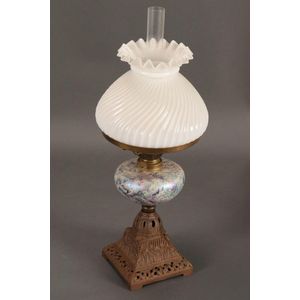
Antique Kerosene Lamp with Milk Glass Shade
Late 19th century kerosene lamp, with milk glass shade and clear glass chimney, set above a mottled font, the whole resting on a tapered cast iron base, base, height 53 cm (including shade)

Victorian banquet lamp with ruby etched glass shade
Late Victorian banquet lamp, with ruby etched glass shade and clear glass chimney, set above a ruby glass font, the whole resting on a gilt metal Corinthian column base, height 92 cm (including shade)

Salmon Glass Banquet Lamp with Dual Burners and Base
Vintage metal & glass banquet lamp salmon coloured glass font, to oil banquet lamp, with dual British burners and iron metal base, and including glass funnel, height 60 cm, total.
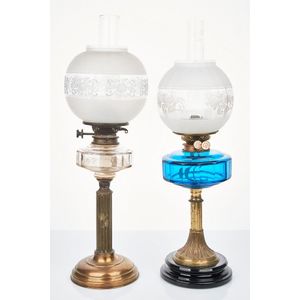
Victorian Oil Lamps by Hinks & Sons
Hinks & Sons, two Victorian pressed metal and cut glass oil lamps, with bayonet duplex burners, clear and blue glass fonts, fluted gilt-metal columns (2), height 63.5 cm, 65 cm. Provenance: The collection of Robert Hutchinson, Sydney

Victorian Ruby Banquet Lamp
A Victorian ruby banquet lamp, circa 1890, the original frosted pressed glass ruby shade on a plain ruby glass font on a pierced cast metal base with copper highlights, height 72.5 cm
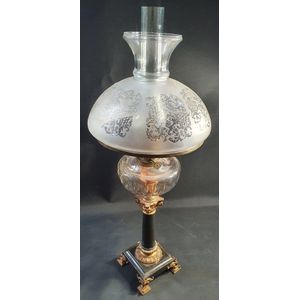
Victorian Corinthian Column Oil Lamp with Frosted Shade
A late Victorian oil lamp, the gilt metal and black granite Corinthian column support with frosted glass shade and a chimey, raised on four gilt metal feet. Overall height to tip of chimney 68 cm.

Britannia Oil Lamp with Phoenix Feet
An antique oil lamp modelled as Britannia, the painted metal figure adjacent the mask head and acanthus leaf lamp support, the green tinged glass reservoir moulded with stars, all raised on four scrolling phoenix feet. Overall height to top of chimney 84…

Victorian Cherub Oil Lamp with Floral Base
A late Victorian oil lamp, the metal column modelled as two cherubs supporting the white glass reservoir and shade, above a floral base. Height to top of chimney 60 cm.
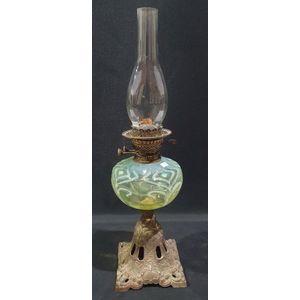
Victorian Vaseline Glass Oil Lamp on Metal Base
A late Victorian oil lamp, the vaseline glass reservoir held above a pierced metal square form base. Overall height 61 cm.

Cherub Majolica Oil Lamp with Etched Glass Shade
An impressive Budapest Majolica oil lamp, the baluster body decorated with cherubs and foliate scrollwork, the whole supported on four gilt metal scrolling acanthus capped feet, the body with gilt metal cherub supports, the etched glass shade above and…

Turquoise Enamelled French Oil Lamp with Lionmask Handles
A late 19th century French oil lamp, the pale turquoise glass body well enamelled with flowers and floral swags, gilt metal lionmask handles (loose), the fuel reservoir lift out, and raised on a gilt metal circular stand with four scrolling and mask head…
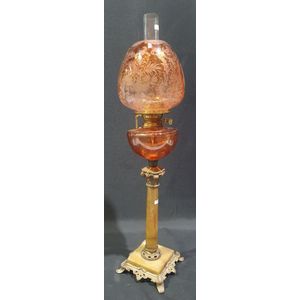
Victorian Oil Lamp on Corinthian Column Base
A late Victorian oil lamp, pale red reservoir and etched glass shade, held above a stone and gilt metal Corinthian column, on square base and four scrolling legs. Overall height 78 cm.

Victorian Spelter Figural Oil Lamp with Green Glass Shade
A Victorian spelter figural oil lamp, with pale green glass font and shade, 75 cm high
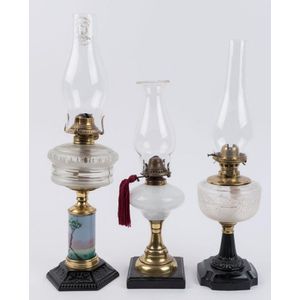
Set of Three Early 20th Century Kerosene Lamps
Three kerosene lamps on black painted cast iron bases, brass single burners and clear glass chimneys, early 20th century, (3 items), the largest 55 cm high
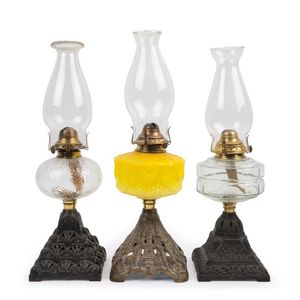
Set of Three Antique Kerosene Lamps with Glass Fonts
Three kerosene lamps with cast iron bases, each with pressed glass fonts, one canary yellow with flower decoration, the other two of clear pressed glass, each with single brass burner and glass chimneys, early 20th century, (3 items), the largest 51 cm…

Floral Cast Iron Kerosene Lamps (3) - Late 19th Century
Three kerosene lamps with floral cast iron bases, each with glass fonts, late 19th century, (3 items), the largest 55 cm high
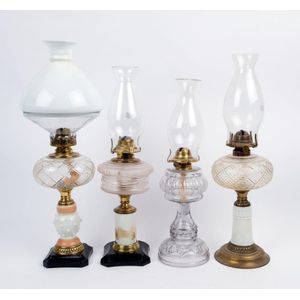
Kerosene Lamps with Coloured and Pressed Glass (9 words)
Four kerosene lamps, two with coloured glass columns, another with pressed white and peach glass stand on ebonised cast metal base, the fourth with clear pressed glass stand with impressed floral design and reeded font, all with brass burners and clear…

Art Nouveau Kerosene Lamps with Coloured Glass Fonts
Three kerosene lamps each with gilt painted cast metal bases, one depicting King Edward VII, the other two with Art Nouveau cast decoration, each with coloured glass fonts, one with painted floral design, one pastel blue glass with moulded flowers, the…
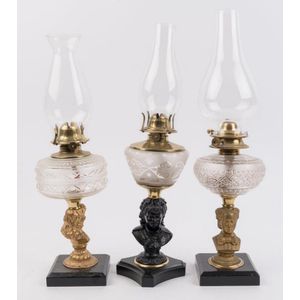
Antique Kerosene Lamps with Cast Bust Stands
Three kerosene lamps with cast bust stands on ebonised cast metal bases, pressed glass fonts, one with frosted decoration, all with single brass burners and glass chimneys, late 19th century, (3 items), the largest 56 cm high
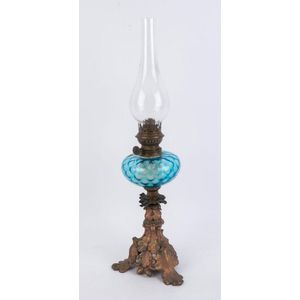
19th Century Oak Leaf Kerosene Lamp with Blue Font
An antique kerosene lamp, cast metal oak leaf base, blue font, single burner with glass chimney, 19th century, 62 cm high overall

Antique Oil Lamps Trio: Amber, Crystal, Metal Fonts
Three antique oil lamps, 19th and early 20th century, one with amber font, one with cut crystal font and the other with metal font, the largest 50 cm high
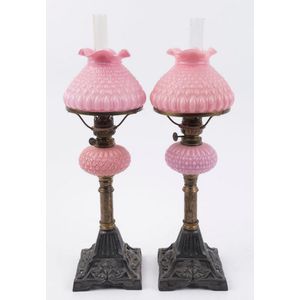
Antique Oil Lamps with Pink Quilted Glass Shades
A pair of antique oil lamps with quilted pink glass shades and fonts, single burners on brass and cast metal bases, 19th century, 51 cm high

Pair of Floral Kerosene Lamps with Glass Fonts
Two kerosene lamps, each with cast metal bases with floral decoration, one with squat clear glass font, the other with a green moulded and reeded glass font, brass single burners and glass chimneys, early 20th century, (2 items), the taller 44 cm high
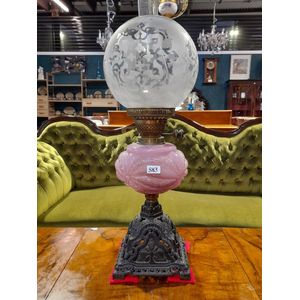
Embossed Pink Banquet Lamp with Cast Iron Base
A fine banquet lamp, embossed pink reservoir, etched bulbous shade with a cast iron base
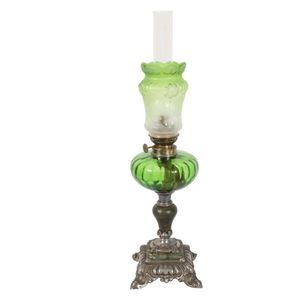
19th Century Fuel Lamp with Green Glass Font
Fuel lamp, late 19th century, marble and spelter with green glass font, height 61 cm

Mottled Blue Glass Oil Lamp
Oil lamp, late 19th century, marble and spelter base with mottled blue glass font, height 60 cm
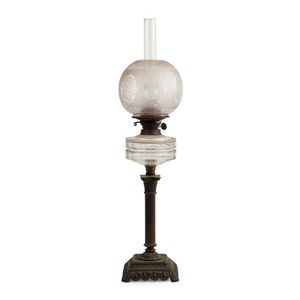
Antique Corinthian Banquet Lamp with Etched Shade
An antique banquet lamp, cast metal Corinthian base, faceted crystal font, white button double burner and original acid etch shade and chimney, 19th century, 77 cm high overall
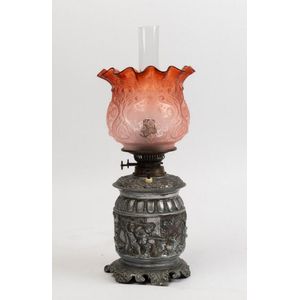
Antique Electrified Oil Lamp with Ruby Glass Shade
An antique oil lamp with cast metal base, double burner, acid etched ruby glass shade and glass chimney, (electrified), late 19th century, 52 cm high
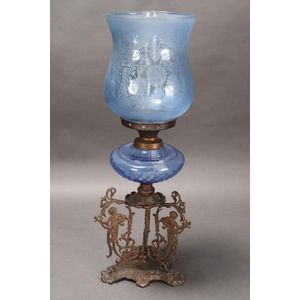
Blue Glass Victorian Oil Lamp with Classical Figures Support
Late Victorian oil lamp, with blue etched glass shade above a blue glass body, raised on metal support in the form of classical figures, height 63 cm
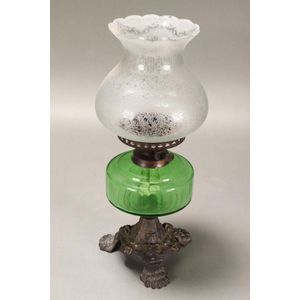
Victorian Kerosene Lamp with Etched Glass Shade
Late Victorian kerosene lamp, with etched glass shade, above a green glass body resting on a metal tri-footed stand, height 47 cm

Vintage Crystal Banquet Lamp with Green Glass Decoration
Good vintage crystal banquet lamp brass double burner, to lamp shade with green glass decoration, to crystal fuel font, and silvered metal base, height 65 cm.
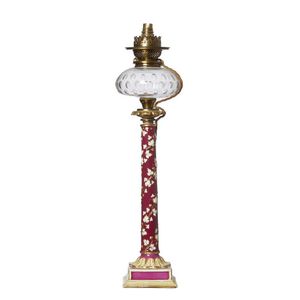
William IV Porcelain Kerosene Lamp with Gilt and Glass
A William IV porcelain table kerosene lamp, the square moulded foot rising to pedestal and a leaf moulded socle, the columnar shaft moulded with hops and decorated gilt and cream on a crimson ground, with a gilt metal foliate mount and cut glass reservoir…
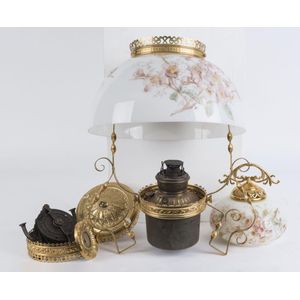
Gilt Metal Miller Parlor Lamp - 19th Century
Miller parlour lamp, gilt metal and glass, 19th century, 85 cm high

Art Nouveau Oil Lamp with Victorian Cast Iron Base
Victorian cast iron base oil lamp with Art Nouveau decorated reservoir
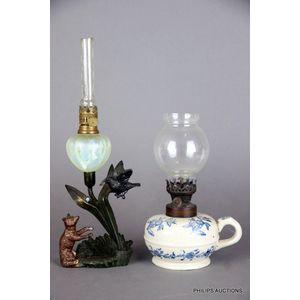
Vintage Fuel Lamps with Unique Designs
Two petite vintage fuel lamps, 19th to early 20th century, a blue and white porcelain lamp base with ring handle supporting the burner, mechanism and a bulbous glass chimney, and a lead weighted spelter lamp, featuring a bird with a biscuit tormenting a…
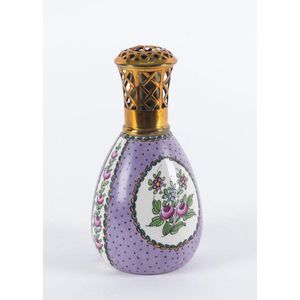
Desvres Porcelain Oil Lamp with Gilt Metal Cover
Desvres French porcelain oil lamp with gilt metal cover, late 19th century, marked 'Desvres, France, G.S. Made in France, 17.5 cm high

Antique German Fuel Banquet Lamp with Turquoise Font
An antique German fuel banquet lamp, circa 1900, maker's mark for Brenner Kosmos, a pierced foliate spelter base supporting a clear turquoise font with an internal lobed decor, a spiral twist mushroom milk glass shade with a frilled, top, glass chimney…
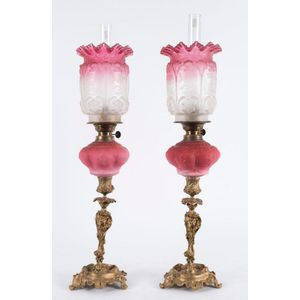
Antique Piano Sconce Oil Lamps with Ruby Glass Shades
A pair of antique piano sconce kerosene oil lamps with ruby glass fonts and shades and gilt metal stands, 19th century, 55 cm high
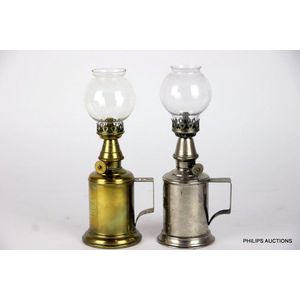
French Brass Kerosene Lamps, Late 19th Century
A pair of vintage French lamps in brass and white metal, late 19th century, one 'Lampe Pigeon' and one 'Lampe Olympe', kerosene lamps with all fittings, and glass chimneys, height 23 cm

19th Century Kerosene Table Lamp with Eagle Burner
Kerosene table lamp mid 19th century U.S.A. Cast iron & glass. With single Wick eagle burner

Victorian Battle Scene Spirit Lamp
Late Victorian spirit lamp spelter base, depicting Colonial Battle scene, brass fittings and milk glass shade, height 53 cm
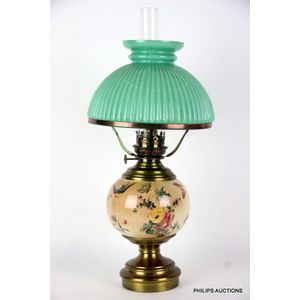
French Ceramic Fuel Lamp with Floral Designs
An antique French fuel lamp, early 20th century, with a ceramic globular font decorated with floral, bird and insect, transferware designs, raised on a circular metal base, with original mounts, and fittings, glass chimney and a mint green ribbed and…

French Ceramic Fuel Lamp with Floral Design
An antique French fuel lamp, early 20th century, with a ceramic globular font decorated with floral, bird and insect, transferware designs, raised on a circular metal base, with original mounts, and fittings, glass chimney and a pink domed glass shade,…

Scott's Cranberry Banquet Lamp
Banquet lamp by John Scott, England, metal, decorative base, with cranberry glass shade, height 87 cm
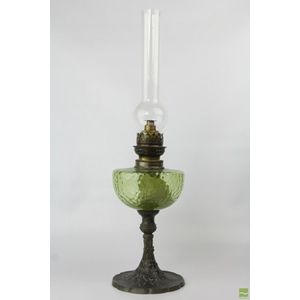
Art Nouveau Oil Lamp with Green Glass Reservoir
Antique oil lamp with green glass Reservoir and Art Nouveau base good example with tree form Nouveau metal base and 'Dimpled' green glass reservoir and glass chimney, height 56 cm

Blue Glass Oil Lamp with Metal Base and Chimney
Oil lamp with blue glass Reservoir on a pierced metal base, with resin and turned metal stem pressed and shaped blue glass reservoir and brass burner/holder & glass chimney, height 58 cm

Green Glass Oil Lamp with Filigree Cast Iron Base
A green glass & cast iron oil lamp, with filigree cast iron base & a fluted green glass centre, height 32 cm

French Metal Oil Signal Lamp with Brass Plaque
Antique French 'Poyard' metal oil signal lamp, marked to body, with brass plaque specifying details. Believed to be in working condition. Height 36 cm
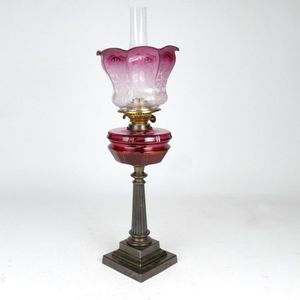
Victorian Cranberry Kerosene Lamp with Etched Shade
A Victorian cast iron and cranberry kerosene lamp, the stepped base supporting an Ionic column, with cranberry glass oil reservoir, etched shade and chimney. Height 66 cm

Victorian Vaseline Glass Kerosene Lamp with Etched Shade
A Victorian Vaseline glass kerosene lamp, the metal pyramid shape base with pierced and floral decoration, the oil reservoir of primrose Vaseline glass decorated with flowers, etched glass shade and chimney. Height 59 cm

Victorian Oil Lamp Set with Milk and Clear Glass Shade
Late Victorian oil lamp set with milk and clear glass shade above facetted bowl, on gilt metal stand, height 41 cm

Blue Glass Kerosene Lamp with Cast Metal Base
Antique kerosene lamp, with blue glass reservoir and cast metal base, height 50 cm approx

Ruby Cast Iron Double Burner Parlour Lamp
Elaborate cast iron parlour lamp with ruby glass font and shade (double burner)

Brass and Ceramic Metal Fuel Lamp
Early metal fuel lamp. Ceramic covered brass base on four paw feet, with original white glass shade & glass chimney.

Victorian Green Glass Kerosene Lamp with Cherub Handles
A Victorian kerosene lamp, the green glass body painted with florals and geometric designs on a gilded metal base, with cherub handles to each side, with Duplex burners, frosted shade hand painted with florals and glass chimney, with later electrical…

American Floral Banquet Lamp with Gilded Base
American banquet lamp & shade on a gilded cast metal base with a removable brass well, & a hand painted floral ball shade, stamped 'Made in America'. condition good, minor age related wear consistant with age. Height including ball shade 73 cm

Victorian porcelain and spelter kerosene lamp
A Victorian porcelain and spelter kerosene lamp, later 19th century, with maker's mark for John Scott, England, the lamp with a bulbous waisted font decorated with floral bouquets to roundels and moulded foliate lug handles held within foliate spelter…
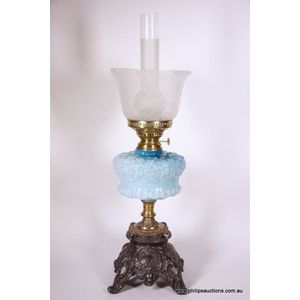
Victorian Art Nouveau Kerosene Banquet Lamp
A Victorian Art Nouveau kerosene banquet lamp, late 19th century, the glass, brass and white metal lamp having a floral patterned frosted shade enclosing a chimney, a moulded pale blue milk glass font with flowers, buds and fruits above a brass stem and a…

Ruby Glass Kerosene Lamp with Double Burner & Metal Base
A ruby glass kerosene lamp with cast metal base & double burner

Gaudard Ruby Glass Kerosene Banquet Lamp with Floral Design
Gaudard French ruby glass kerosene banquet lamp with a ruby floral well, flu & shade on a gilded metal stand. Condition good, small chip to the bowl rim. Height 71 cm
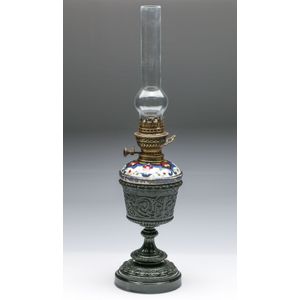
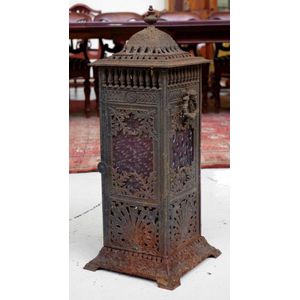


 Loading more...
Loading more...